Global Diarrhea Burden
Diarrhea: Common Illness, Global Killer
Fact Sheets: Diarrhea: Common Illness, Global Killer (Africa cover) [PDF - 4 pages]
Diarrhea: Common Illness, Global Killer (Asia cover) [PDF - 4 pages]
Diarrhea: Common Illness, Global Killer (Latin American cover) [PDF - 4 pages]
Diarrhea kills 2,195 children every day—more than AIDS, malaria, and measles combined 1.
Diarrheal diseases account for 1 in 9 child deaths worldwide, making diarrhea the second leading cause of death among children under the age of 5. For children with HIV, diarrhea is even more deadly; the death rate for these children is 11 times higher than the rate for children without HIV 2. Despite these sobering statistics, strides made over the last 20 years have shown that, in addition to rotavirus vaccination and breastfeeding, diarrhea prevention focused on safe water and improved hygiene and sanitation is not only possible, but cost effective: every $1 invested yields an average return of $25.50 3.
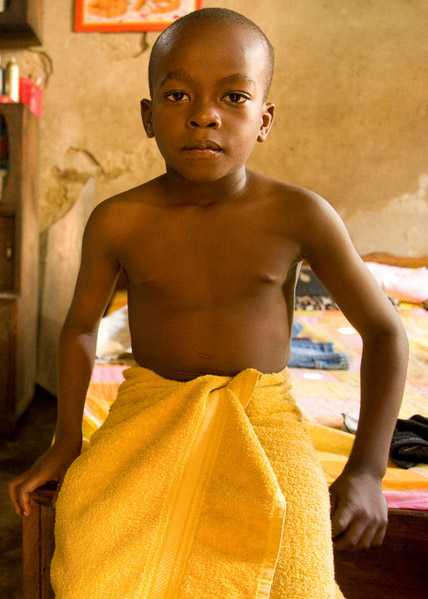
Learn how simple and inexpensive interventions to prevent and treat diarrhea can save the lives of children around the world.
Stopping Diarrhea
Most diarrheal deaths are preventable using simple, low-cost interventions.
Diarrhea: What we know
- It causes death by depleting body fluids resulting in profound dehydration.
- Diarrhea can have a detrimental impact on childhood growth and cognitive development 4.
- About 88% of diarrhea-associated deaths are attributable to unsafe water, inadequate sanitation, and insufficient hygiene 5, 6.
- Rotavirus is the leading cause of acute diarrhea and causes about 40% of hospitalizations for diarrhea in children under 5 7.
- Most diarrheal germs are spread from the stool of one person to the mouth of another. These germs are usually spread through contaminated water, food, or objects.
-
Diarrhea Deaths
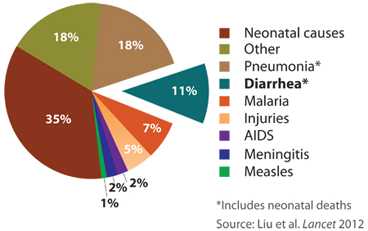
Diarrhea kills more children than malaria, measles, and AIDS combined. Proportional distribution of cause-specific deaths among children under five years of age, 2012 (excluding neonatal deaths) 1.
- Water, food, and objects become contaminated with stool in many ways:
- People and animals defecate in or near water sources that people drink.
- Contaminated water is used to irrigate crops.
- Food preparers do not wash their hands before cooking.
- People with contaminated hands touch objects, such as doorknobs, tools,
or cooking utensils.
Diarrhea: Proven Ways to Save Lives
- Vaccinate for rotavirus
- Provide
- Safe water
- Adequate sanitation and human waste disposal
- Promote
- Handwashing with soap
- Breastfeeding to reduce exposure to contaminated water
- Treat appropriately with oral rehydration therapy and antibiotics
- Train health care providers and community health workers on diarrhea treatment
- Educate mothers and caretakers about caring for ill children and when to seek medical assistance
- Build laboratory diagnostic capability and identify the causes of diarrhea
Pathways to Diarrhea
Pathways to Diarrhea

Pathways to Diarrhea. Illustrates how contamination can occur. Click to enlarge.
What Can Be Done
Use effective interventions and proven treatment for diarrhea.
Governments and ministries of health can:
- Provide rotavirus vaccination
- Invest in safe drinking water, hygiene, and sanitation infrastructure
- Monitor progress and needs through the collection, analysis, and reporting of quality data
- Support clear and targeted health promotion and behavior change programs
Non-governmental/aid organizations can:
- Increase the adoption of proven measures against diarrhea
- Rotavirus vaccination
- Breastfeeding
- Oral rehydration therapy
- Household and community systems for treating and storing water
- Educate communities on the importance of safe water, sanitation, and hygiene
- Enhance and support government initiatives that invest in safe drinking water, sanitation, and hygiene infrastructure
- Ensure the sustainability of interventions
- Focus on the provision of safe water, sanitation, and hygiene when responding to emergency and conflict situations
Health care providers and clinical facilities can:
- Ensure availability of adequate medical supplies such as oral rehydration solution
- Improve training programs for health workers and educate them on the proper treatment of diarrhea
- Ensure that facilities for handwashing, provision of safe water, and proper disposal of human waste are provided at ALL healthcare facilities
- Encourage appropriate antibiotic use
- Meet demand for health workers
- Support community health workers
- Improve training programs
- Seek creative ways to motivate them
Communities can:
- Support and promote the importance of community health workers
- Ensure safe water is provided close to people’s homes
- Discourage/eliminate open defecation
- Develop strategies for proper disposal of human waste
- Construct basic sanitation facilities
- Promote handwashing
Preventing Diarrhea, Saving Lives
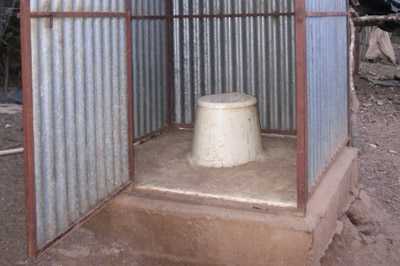
Safe water/adequate sanitation: Treat water before use and dispose of waste safely.
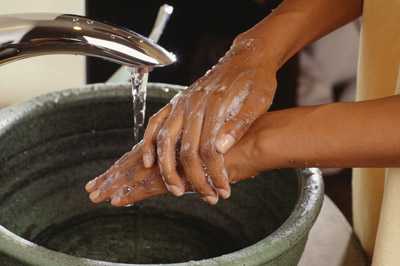
Improved hygiene: Wash hands when appropriate.
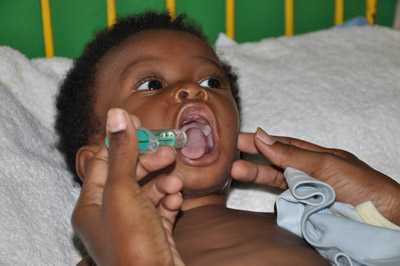
Routine vaccination: Provide rotavirus vaccine.
References
- Liu L, Johnson HL, Cousens S, Perin J, Scott S, Lawn JE, Rudan I, Campbell H, Cibulskis R, Li M, Mathers C, Black RE; Child Health Epidemiology Reference Group of WHO and UNICEF. Global, regional, and national causes of child mortality: an updated systematic analysis for 2010 with time trends since 2000. Lancet. 2012;379(9832):2151-61.
- Hutton G, Haller L, Bartram J. Global cost-benefit analysis of water supply and sanitation interventions. J Water Health. 2007;5(4):481-502.
- Tindyebwa D et al. Common clinical conditions associated with HIV. Handbook on Paediatric AIDS in Africa. 2004.
- Bowen A, Agboatwalla M, Luby S, Tobery T, Ayers T, Hoekstra RM. Association between intensive handwashing and child development in Karachi, Pakistan: A cluster controlled trial. Arch Pediatr Adolesc Med. 2012 Sep; [Epub ahead of print]
- UNICEF. Progress for children: A report card on water and sanitation. Number 5, September 2006.
- Black RE, Morris S, Bryce J. Where and why are 10 million children dying every year? Lancet. 2003;361(9376):2226-34.
- WHO. Weekly epidemiological record. [PDF - 8 pages] 2008;83(47):421–8.
- Page last reviewed: December 17, 2015
- Page last updated: December 17, 2015
- Content source:


 ShareCompartir
ShareCompartir